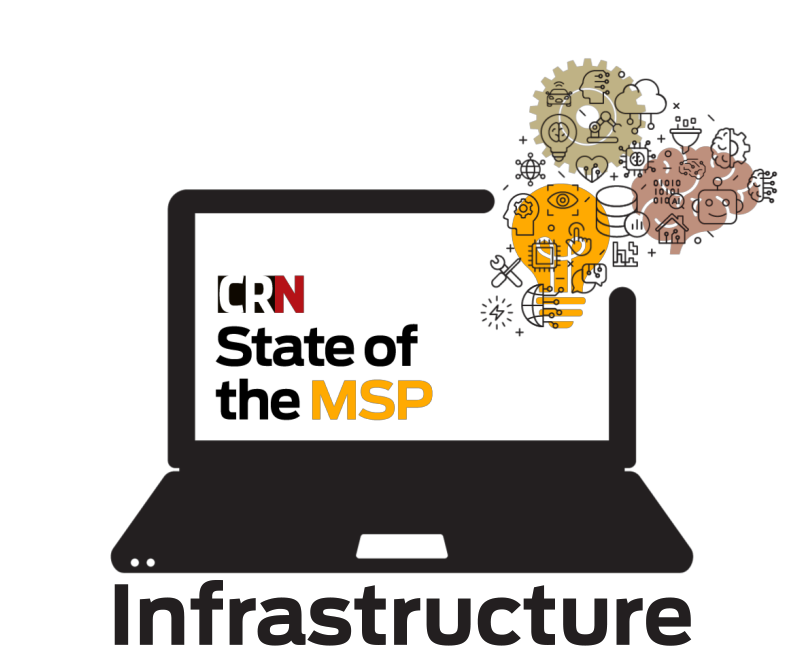

With IT environments growing in complexity, security remaining a top concern, application modernisation continuing and the AI story evolving, the outlook for managed infrastructure providers seems good.
Indeed, in early 2023, CRN Australia asked end user organisations about the main services they looked for from MSPs - infrastructure services were the second most popular.
In January this year, Gartner forecast that worldwide IT spending would grow by 2.4 percent, down from the previous quarters forecast. MSPs’ challenge will be balancing complex customer demands with tighter budgets.
“The demand from customers is higher,” Intellect IT director Max Soukhomlinov told CRN Australia. “It’s just a case of being able to navigate that journey to make sure that you try and balance the complexity to ensure that you're able to add a significant amount of value whilst being cost effective.”
“Mode three” IT

Ai for IT operations, or AIOps, as the marketers like to call it, continues to be a predicted growth area amid skills shortages, tight budgets and a push for more proactive management of IT
Last year, Datacom announced that AIOps would help it enhance operational delivery of IT services for Australia's Department of Health, and up to 80 percent of the department's cloud workloads would be automatically provisioned.
Vendors have been buying into the technology, purchasing AIOps companies and building data lakes. Late last year, Forrester described the AOPs platform market as moving “faster than can be imagined”.
AI and machine learning have the potential to reshape MSP offerings, according to Interactive’s general manager for digital transformation, Dan Cox.
In Cox’s view, mode one teams focus on prediction and optimisation, while mode two teams focus more on innovation and experimentation. Then there is a “mode three and the dawn of a new era, particularly around AI and machine learning”.
“We see this today, particularly in cybersecurity and operations and customer experience – lots of predictability and patterns that enrich the customer experience, reduce human error, shorten lead times,” Cox said.
“There's also a huge value opportunity for these technologies in creating new revenue streams for organisations. And I see that being a huge area of investment,” he said.
“Create a wrapper” around infrastructure

Customers need to simplify and secure hybrid IT environments also remains.
Stitching together a complex mix of cloud systems from a number of vendors is a confronting challenge for small and mid-size organisations, Cox pointed out.
“What we need to do is be opinionated. Take some of that complexity out of the market and bring business value in a really simplistic way so that people can address the risk that's out there and meet the compliance and the standards expected, either of a regulatory body or the cyber insurers,” Cox said.
“We almost assume that every organization has a plethora of cloud platforms – whether they be traditional infrastructure platform-as-a-service or software-as-a-service. Most established businesses have a bit of everything.”
“Therefore the service model really needs to assume that and create a wrapper around various generations of IT.”
Intellect IT’s Max Soukhomlinov noted the rise in interest in security services and its impact on the role of an infrastructure MSP.
“The key component as far as the backbone of the historical managed service delivery has been a very effective and proficient management of infrastructure,” Soukhomlinov noted.
“The backbone – that's still a requirement, but it's expanded into proficient management of security controls and visibility.”
In Soukhomlinov’s view, a focus on people, processes and systems, combined with complexity and a skills shortage has resulted in more customers leaning towards outsourcing the majority of ICT operations and security.
“50% of those conversations about integrations”

Focus on full-time DevOps and operational environments has also continued to create demand for MSPs, Soukhomlinov reported.
Automation and “very tight integration” are becoming the norm, he said.
“That is a demand on us from customers, it’s a demand that we put internally and it's a demand that we're putting onto our service providers that provide us the platforms and the systems, be it from RMM monitoring all the way through to PSAs and auxiliary systems that sit around it,” according to Soukhomlinov.
“If I look at most of the conversations that we're having now with customers as well as our vendors …50% of those conversations are about depth and complexity of integrations.”
Application modernisation also continues to drive customers’ infrastructure and services needs.
Soukhomlinov expects a significant increase in the use of containers or microservices. “At the moment it makes up five, 10 percent on average across the customer base – and there's a lot of fat applications,” he said. He expected that to increase to “close to 50 percent across the board.”
Sovereign cloud, edge IT and sustainability

Demand for sovereign cloud continues too, reports Jaideep Thyagarajan, senior principal analyst at Gartner.
“That is really causing local cloud market ecosystems to grow,” Thyagarajan observed. He flagged a “new wave of cloud adopters who only trust specific regions and data sovereignty regulations that cover specific requirements,” he said.
Other factors influencing infrastructure needs include the Internet of Things and edge computing.
The environmental sustainability of data centres is also expected to be scrutinised as companies examine the carbon footprint of their supply chains to meet scope three targets.
“What was a nice-to-have capability is today a must-have capability. And it's very use-case driven. It’s just not a lip service that used to happen a few years ago. Everybody wanted to say ‘Oh, we are going to carbon neutrality. Oh, we are going to control emissions.’ It's no longer that and it's really about very specific use cases,” he said.
Advising, not replacing
Perhaps the biggest takeaway is that increasing complexity and greater customer demands on infrastructure providers have created a need for MSPs to move further into advisory capacities.
Interactive’s Dan Cox commented: “We see our role as evolving. We continue to provide access to expertise and technology and guidance, but that role is very much about empowerment and advisory – continuing to optimise, govern and transform, but perhaps doing it in a way that we're advising the customer, not replacing parts of the customer organisation. And I think that sentiment has really shifted in recent years.”
MSP Champions
The CRN State of MSP Champions — NinjaOne and Pure Storage — work with MSPs to ensure IT buyers receive the most appropriate solutions and the highest service levels.
Watch their comments below about how MSPs can continue to thrive in the year ahead.








